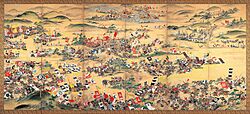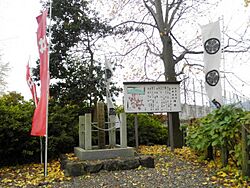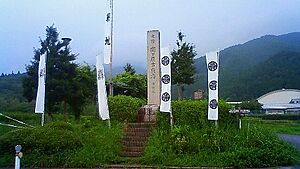Battle of Sekigahara facts for kids
Quick facts for kids Battle of Sekigahara |
|||||||||
|---|---|---|---|---|---|---|---|---|---|
| Part of the Sengoku period | |||||||||
 Edo-period screen depicting the battle |
|||||||||
|
|||||||||
| Belligerents | |||||||||
| Western Army: Forces loyal to Ishida Mitsunari, many clans from Western Japan | Eastern Army: Forces loyal to Tokugawa Ieyasu, clans of Eastern Japan | ||||||||
| Commanders and leaders | |||||||||
| Ishida Mitsunari Ukita Hideie Ōtani Yoshitsugu † Shima Sakon † Chōsokabe Morichika Gamō Yorisato † Shimazu Yoshihiro Shimazu Toyohisa † Akashi Takenori Konishi Yukinaga Toda Katsushige † Ankokuji Ekei Mōri Hidemoto Natsuka Masaie † Hiratsuka Tamehiro † Defected: Kobayakawa Hideaki Kikkawa Hiroie Wakisaka Yasuharu Kutsuki Mototsuna Akaza Naoyasu Ogawa Suketada |
Tokugawa Ieyasu: Overall commander Ii Naomasa: Supreme field commander Fukushima Masanori Tōdō Takatora Hosokawa Tadaoki Ikeda Terumasa Oda Urakusai Matsudaira Tadayoshi Kuroda Nagamasa Takenaka Shigekado Honda Tadakatsu Furuta Shigekatsu Katō Yoshiaki Terazawa Hirotaka Ikoma Kazumasa Tsutsui Sadatsugu Horio Tadauji Kanamori Nagachika Asano Yoshinaga Yamauchi Katsutoyo Kyōgoku Takatomo |
||||||||
| Strength | |||||||||
| 120,000 initially, 81,890 by the time of battle |
75,000 initially, 88,888 by the time of battle |
||||||||
| Casualties and losses | |||||||||
|
Sekigahara Gunki Taisei: 8,000–32,000 killed Tokugawa Jikki; The Chronicles of Toshogu Shrine: 35,270 killed |
Sekigahara Gunki Taisei: 4,000–10,000 killed |
||||||||
The Battle of Sekigahara was a huge and very important battle in Japan that happened on October 21, 1600. It marked the end of a long period of wars called the Sengoku period. The battle took place in what is now Gifu Prefecture.
It was a fight between two big armies: one led by Tokugawa Ieyasu (the Eastern Army) and another by Ishida Mitsunari (the Western Army). Many commanders from the Western Army changed sides during the battle, which helped Ieyasu win. The Battle of Sekigahara was the largest battle in Japanese feudal history. It is often seen as the most important one.
Mitsunari's defeat at Sekigahara led to the start of the Tokugawa shogunate. This powerful government ruled Japan for over 250 years, bringing a long period of peace.
Contents
Why the Battle Happened
The years before the battle were very unsettled in Japan. The powerful leader Toyotomi Hideyoshi had died, and his son, Toyotomi Hideyori, was only 5 years old. This created a big power struggle.
Rival Groups Form
After Hideyoshi's death, two main groups started to form. Ishida Mitsunari and some other generals had disagreements. Tokugawa Ieyasu saw this as a chance to gain more power. He brought together generals like Katō Kiyomasa and Fukushima Masanori to challenge Mitsunari.
Political tensions were very high. There were rumors that people tried to assassinate Ieyasu. Also, a powerful lord named Uesugi Kagekatsu started building up his army. Ieyasu asked him why, but Kagekatsu's advisor sent a rude letter back.
Mitsunari then secretly met with other lords to create an army against Ieyasu. They chose Mōri Terumoto as their main leader. This group became known as the Western Army. Terumoto quickly took over Osaka Castle. Meanwhile, Ieyasu's main army was still far away, dealing with Kagekatsu.
Plans Go Wrong
Mitsunari first wanted to use Gifu Castle and Ōgaki Castle to block Ieyasu's Eastern Army. But his plans didn't work out:
- The Eastern Army, led by Fukushima Masanori and Ii Naomasa, captured Gifu Castle before the Western Army arrived.
- On October 19, Shimazu Yoshihiro's troops were defeated near Sone Castle.
- Mitsunari realized that Ieyasu's army was heading towards Osaka Castle.
Because of these problems, Mitsunari changed his plan. He decided to fight a big open battle at Sekigahara against Ieyasu's main army. Ieyasu had already bought many matchlock guns for this fight.
Just one day before the battle, a Western Army general named Kikkawa Hiroie secretly made a deal with the Eastern Army. He promised that the Mōri clan would switch sides during the battle if they were pardoned afterward.
The Battle Begins
On October 21, 1600, at dawn, Ieyasu's leading troops accidentally ran into Mitsunari's army. A thick fog made it hard to see. Both sides were surprised, but now they knew each other was there. Mitsunari set up his army in a defensive position. Ieyasu placed his forces south of the Western Army. The battle began around 10:00 AM.
The fight started when Ii Naomasa led his famous unit of 3,600 soldiers, known as "Ii's red devils," to attack the center of the Western Army. Fukushima Masanori followed him, attacking troops led by Ukita Hideie.
The battle quickly became a tough struggle. One person who was there wrote that "friends and foes are pushing each other" and "gunfire thunders while hails of arrows fly in the sky." The Tokugawa army even used 19 cannons from a Dutch trading ship called De Liefde.
Western Army Changes Sides
During the Battle of Sekigahara, several Western Army commanders switched sides. This changed the whole battle. The most important defector was Kobayakawa Hideaki, who was Toyotomi Hideyoshi's nephew. Ieyasu had convinced him to join his side.
There are two main ideas about when Hideaki switched sides:
- Some say he was unsure during the battle and only joined the Eastern Army around noon. They even say Ieyasu ordered his soldiers to fire at Hideaki's position to make him choose.
- However, many modern historians believe Hideaki had already agreed to join Ieyasu before the battle started. They say the story about Ieyasu shooting at him might just be a dramatic tale from later times.
No matter when it happened, Kobayakawa's forces attacked Ōtani Yoshitsugu's position. At the same time, Yoshitsugu's troops were also fighting units led by Tōdō Takatora.
After Hideaki's betrayal, other Western Army leaders like Wakisaka Yasuharu, Ogawa Suketada, Akaza Naoyasu, and Kutsuki Mototsuna also switched sides. This made the Eastern Army even stronger. These commanders had secretly made deals with Tōdō Takatora days before the battle.
Mōri Terumoto, the official head of the Western Army, also didn't join the battle. He kept his forces at Osaka Castle and later surrendered to Ieyasu. Some of his troops did fight with the Western Army, but their efforts were blocked by Kikkawa Hiroie, who was secretly helping Ieyasu.
Western Army Falls Apart
One of the first weak spots in the Western Army was on Ukita Hideie's side. His troops started to lose ground against Fukushima Masanori's forces. Hideie had to use new recruits and hired soldiers, who were not as skilled as Fukushima's trained troops. This caused Hideie's army to break and collapse.
To the south, Ōtani Yoshitsugu was outnumbered by Kobayakawa Hideaki's attacking forces. Yoshitsugu took his own life, and his troops retreated. This left the Western Army's right side open. Masanori and Hideaki used this to attack the Western Army from the side. Mitsunari saw that the situation was hopeless and began to retreat his own troops.
Meanwhile, Western Army commander Shima Sakon was fighting Kuroda Nagamasa's troops. Sakon was badly wounded by a gun shot.

Edo period screen depicting the Battle of Sekigahara – 160,000 men fought on 21 October 1600.
|
After Sakon's unit gave up, Shimazu Yoshihiro found his troops completely surrounded. He managed to escape with only about 200 soldiers left, but they suffered heavy losses. They were chased by Ii Naomasa until he was also wounded by a rifleman.
The Western Army kept falling apart as more and more soldiers switched sides or fled. The battle ended quickly. Some historians believe the entire battle at Sekigahara lasted only about 2 hours, from 10 AM to noon.
Troops Who Missed the Battle
Many soldiers from both sides did not make it to the Battle of Sekigahara.
- About 38,000 Eastern Army soldiers, led by Tokugawa Hidetada, were stuck fighting at the Siege of Ueda against Sanada Masayuki.
- About 15,000 Western Army soldiers were held up at the Siege of Tanabe.
- Another Western Army group, led by Tachibana Muneshige, was delayed at the Siege of Ōtsu. He had to stay at Osaka Castle after hearing the Western Army had been destroyed.
What Happened Next
When the news of the Eastern Army's victory reached Ogaki Castle, the Western Army commander there quickly surrendered. Ieyasu then gave out new lands and military ranks. He rewarded his allies who helped him win.
- Ikeda Terumasa received a large new domain.
- Tōdō Takatora was given a new domain in Imabari.
- Kobayakawa Hideaki, who switched sides, was given a very large domain worth 520,000 koku (a measure of land value).
About 87 Western Army lords had their lands taken away because they supported Mitsunari. The Chōsokabe clan, a long-standing family, lost their domain. It was given to Yamauchi Kazutoyo for his loyalty to Tokugawa.
On September 17, Ieyasu sent his army, led by Kobayakawa Hideaki, to attack Sawayama Castle, Mitsunari's home base. Most of the castle's soldiers were at Sekigahara, so only 2,800 men were left to defend it. Mitsunari's father and brother led the defense, but the castle eventually fell. Most of Mitsunari's family members were killed or took their own lives.
Ieyasu also planned to punish the Shimazu clan in Kyushu for supporting the Western Army. However, the head of the clan, Shimazu Yoshihisa, started talks with Ieyasu. With help from other lords, the Shimazu clan avoided punishment. They were the only Western Army clan not to lose land after the defeat at Sekigahara.
On November 6, Ishida Mitsunari, Konishi Yukinaga, and Ankokuji Ekei were captured and executed.
In 1603, Ieyasu was officially made shōgun by the Emperor Go-Yōzei. The Battle of Sekigahara is seen as the real beginning of the Edo period, which brought stability back to Japan. A historian named Hayashi Gahō wrote that "Evil-doers and bandits were vanquished and the entire realm submitted to Lord Ieyasu, praising the establishment of peace..."
In 1931, the battle location was made a Monument of Japan. The spots where Ieyasu's and Mitsunari's armies stood, and where Ōtani Yoshitsugu died, are remembered there.
Battle Facts and Timeline
Here are some of the main commanders and their forces:
| Eastern Army (Tokugawa Force) | |
|---|---|
| Tokugawa Ieyasu (leader): 30,000 men | |
| Katō Kiyomasa: 3,000 men | |
| Fukushima Masanori: 6,000 men | |
| Hosokawa Tadaoki: 5,000 men | |
| Ikeda Terumasa: 4,560 men | |
| Kuroda Nagamasa: 5,400 men | |
| Ii Naomasa: 3,600 men | |
| Western Army (Ishida Force) | |
| Mōri Terumoto (official leader) (not present) | |
| Ishida Mitsunari (actual leader): 4,000 men | |
| Ukita Hideie: 17,000 men | |
| Shimazu Yoshihiro: 1,500 men | |
| Kobayakawa Hideaki (defected): 15,600 men | |
| Konishi Yukinaga: 4,000 men | |
| Ōtani Yoshitsugu: 600 men | |
| Chōsokabe Morichika: 6,600 men | |
Here is a timeline of key events around the Battle of Sekigahara:
- May 7: Ieyasu asks Uesugi Kagekatsu why he is building up his army. Kagekatsu refuses to explain.
- June 8: Ieyasu calls his allies to punish the Uesugi.
- August 17: Ishida Mitsunari and others meet to ask Mōri Terumoto to lead their alliance against Ieyasu.
- August 22: Mōri Terumoto arrives at Osaka Castle and takes command of the Western Army.
- August 23: The Eastern Army captures Gifu Castle.
- August 27: The Western Army begins the Siege of Fushimi.
- September 8: Fushimi Castle falls to the Western Army.
- October 7: Ieyasu leaves Edo with 30,000 men.
- October 14: Ieyasu receives a secret message from Kobayakawa Hideaki, who offers his support.
- October 20: The two armies meet near Akasaka. The Eastern Army retreats to Sekigahara. The Western Army follows.
- October 21: Battle of Sekigahara takes place.
- November 6: Ishida Mitsunari, Konishi Yukinaga, and Ankokuji Ekei are captured and executed.
Sekigahara in Pop Culture
The Battle of Sekigahara is a popular topic in books, movies, and video games:
- In 1966, Ryōtarō Shiba wrote a historical novel called Sekigahara. It was made into a movie in 2017.
- James Clavell included a story about the battle in his 1975 novel Shōgun. This book was later made into a TV series in 2024.
- The video game Kessen (2000) is set during this conflict and features the Battle of Sekigahara.
- The strategy game Total War: Shogun 2 (2011) includes Sekigahara as a historical battle.
- The action RPG video game Nioh (2017) also shows events related to the battle.




